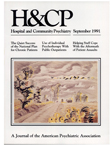Can Multiaxial Diagnosis Predict Future Use of Psychiatric Hospitalization?
Abstract
Demographic and diagnostic intake data on about 10,000 patients at a public psychiatric facility were used to assess whether information recorded on various DSM-III axes could predict the frequency of patients' psychiatric hospitalizations over a follow-up period. Compared with patients who had been hospitalized only once or not at all, patients with three or more hospitalizations during the study period were more likely to be single and black and to come from lower social classes. They were more likely to have an axis I diagnosis of an alcohol-related disorder, a substance use disorder, or a psychotic disorder. When samples from the patient groups were matched on key demographic variables and primary axis I diagnosis, the multiaxial resources of DSM-III were not helpful in predicting future use of hospitalization. The results reinforce the importance of axis I diagnosis and demographic characteristics in assessing course and prognosis.
Access content
To read the fulltext, please use one of the options below to sign in or purchase access.- Personal login
- Institutional Login
- Sign in via OpenAthens
- Register for access
-
Please login/register if you wish to pair your device and check access availability.
Not a subscriber?
PsychiatryOnline subscription options offer access to the DSM-5 library, books, journals, CME, and patient resources. This all-in-one virtual library provides psychiatrists and mental health professionals with key resources for diagnosis, treatment, research, and professional development.
Need more help? PsychiatryOnline Customer Service may be reached by emailing [email protected] or by calling 800-368-5777 (in the U.S.) or 703-907-7322 (outside the U.S.).



